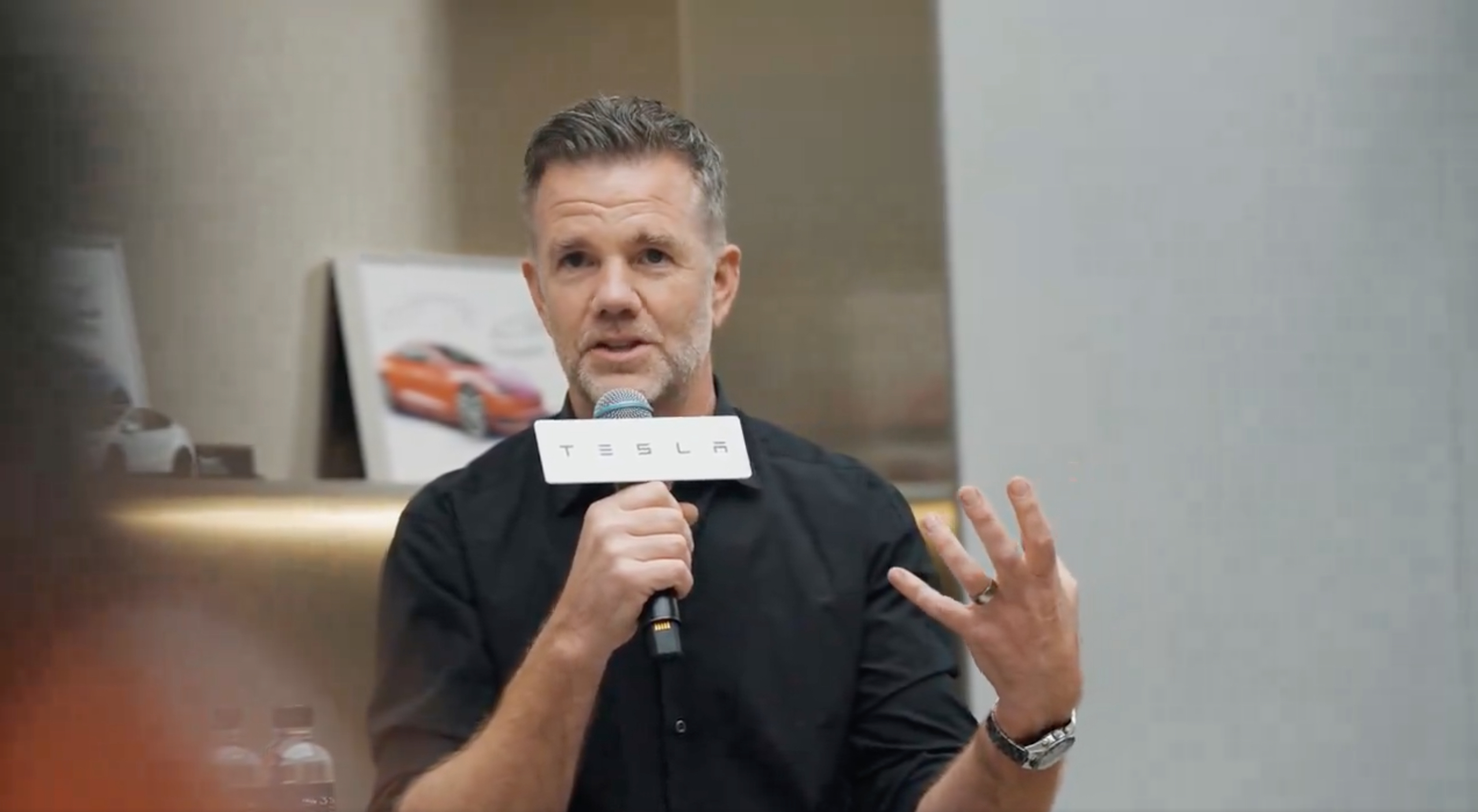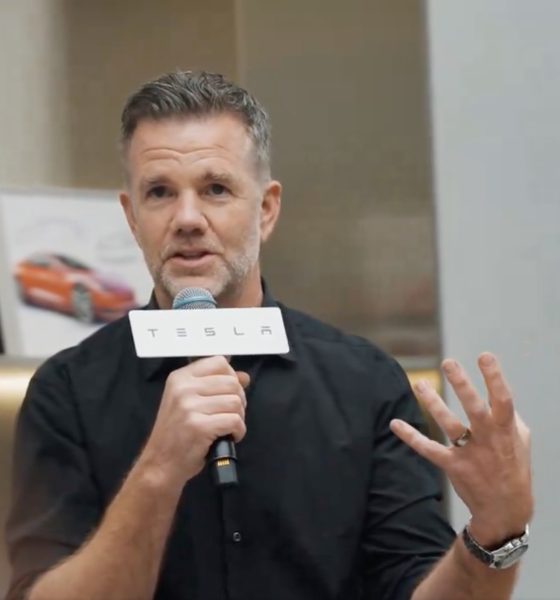Tesla has been boosting its advertising and public education efforts over the last several months, with many executives and employees discussing the company’s electric vehicles (EVs) and other products more publicly and regularly. In one video shared on social media over the weekend, the company’s head of design discussed futuristic aesthetics for the company’s vehicles, along with a call to action for other automakers and more.
In a video posted by the Tesla Asia account on X on Saturday evening, Chief Designer Franz von Holzhausen talks in a behind-the-scenes format about designing “products that felt like the future” — a topic the automaker has regularly discussed over the years, especially with the release of the Cybertruck.
Tesla launches advertising on X in the U.S., expanding ‘small scale’ strategy outlined by Musk
He notes that the notion of vehicle design needing to look like the future initially came from one of CEO Elon Musk’s children, along with a few other interesting details. For one, he notes that the updated Model 3 pays homage to the original Roadster with its full “Tesla” lettering on the rear (rather than just the “T” logo).
Beyond the Model 3 and the Cybertruck, von Holzhausen talks a little bit about the Model S, saying that he and Musk were often discussing “where the ball is going to, not what’s happening today.”
The designer also points out that he originally joined Tesla because of his interest in advancing sustainability, even going on to encourage other automakers to help the world transition to EVs.
“I mean it’s great to hear, I think, in China there are going to be more EVs sold than ICE cars,” von Holzhausen said. “What a great moment to celebrate kind of this transition. It’s hard for one company to do all of that alone. And so we want other people to learn from what we’ve learned to help ultimately make our clients that’s a lot of competition.”
“But competition makes us stronger makes us better, keeps us in the forefront.”
You can watch the video on the Tesla Asia account on X here, or below.
The future should look like the future
BTS of Tesla vehicle design with @woodhaus2 pic.twitter.com/uiLSph9AZQ
— Tesla Asia (@Tesla_Asia) March 24, 2024
Tesla’s latest efforts in advertising and education
Tesla has clearly been experimenting with advertising via social media platforms and more over the last several months. This includes the company’s shift toward having executives, engineers, and other employees interacting directly with owners and fans on X, alongside increased media appearances around the Cybertruck launch.
Along with this and other recent appearances from von Holzhausen, Tesla has been sharing more “citizen-journalism” style content, including a livestream posted by the automaker’s North America account on Friday. Held at one of the company’s stores near the factory in Fremont, California, the livestream features an employee named Brenda answering questions about the Model Y, as can be seen below (or here).
— Tesla North America (@tesla_na) March 22, 2024
As yet another example of recent advertising, Tesla earlier this month had a Cybertruck towing a Model Y encased in glass, featuring the caption, “The Best-Selling Car in the World is Made in America.”
Along with these, there are countless other examples that have been rolling out, after Musk said at last year’s annual shareholder’s meeting that Tesla would begin advertising. The comment followed feedback and questions from many Tesla shareholders as to why the company wasn’t advertising to at least help educate the public and fight misinformation on EVs.
What are your thoughts? Let me know at zach@teslarati.com, find me on X at @zacharyvisconti, or send your tips to us at tips@teslarati.com.

Elon Musk
Elon Musk and Tesla AI Director share insights after empty driver seat Robotaxi rides
The executives’ unoccupied tests hint at the rapid progress of Tesla’s unsupervised Robotaxi efforts.

Tesla CEO Elon Musk and AI Director Ashok Elluswamy celebrated Christmas Eve by sharing personal experiences with Robotaxi vehicles that had no safety monitor or occupant in the driver’s seat. Musk described the system’s “perfect driving” around Austin, while Elluswamy posted video from the back seat, calling it “an amazing experience.”
The executives’ unoccupied tests hint at the rapid progress of Tesla’s unsupervised Robotaxi efforts.
Elon and Ashok’s firsthand Robotaxi insights
Prior to Musk and the Tesla AI Director’s posts, sightings of unmanned Teslas navigating public roads were widely shared on social media. One such vehicle was spotted in Austin, Texas, which Elon Musk acknowleged by stating that “Testing is underway with no occupants in the car.”
Based on his Christmas Eve post, Musk seemed to have tested an unmanned Tesla himself. “A Tesla with no safety monitor in the car and me sitting in the passenger seat took me all around Austin on Sunday with perfect driving,” Musk wrote in his post.
Elluswamy responded with a 2-minute video showing himself in the rear of an unmanned Tesla. The video featured the vehicle’s empty front seats, as well as its smooth handling through real-world traffic. He captioned his video with the words, “It’s an amazing experience!”
Towards Unsupervised operations
During an xAI Hackathon earlier this month, Elon Musk mentioned that Tesla owed be removing Safety Monitors from its Robotaxis in Austin in just three weeks. “Unsupervised is pretty much solved at this point. So there will be Tesla Robotaxis operating in Austin with no one in them. Not even anyone in the passenger seat in about three weeks,” he said. Musk echoed similar estimates at the 2025 Annual Shareholder Meeting and the Q3 2025 earnings call.
Considering the insights that were posted Musk and Elluswamy, it does appear that Tesla is working hard towards operating its Robotaxis with no safety monitors. This is quite impressive considering that the service was launched just earlier this year.
Elon Musk
Starlink passes 9 million active customers just weeks after hitting 8 million
The milestone highlights the accelerating growth of Starlink, which has now been adding over 20,000 new users per day.

SpaceX’s Starlink satellite internet service has continued its rapid global expansion, surpassing 9 million active customers just weeks after crossing the 8 million mark.
The milestone highlights the accelerating growth of Starlink, which has now been adding over 20,000 new users per day.
9 million customers
In a post on X, SpaceX stated that Starlink now serves over 9 million active users across 155 countries, territories, and markets. The company reached 8 million customers in early November, meaning it added roughly 1 million subscribers in under seven weeks, or about 21,275 new users on average per day.
“Starlink is connecting more than 9M active customers with high-speed internet across 155 countries, territories, and many other markets,” Starlink wrote in a post on its official X account. SpaceX President Gwynne Shotwell also celebrated the milestone on X. “A huge thank you to all of our customers and congrats to the Starlink team for such an incredible product,” she wrote.
That growth rate reflects both rising demand for broadband in underserved regions and Starlink’s expanding satellite constellation, which now includes more than 9,000 low-Earth-orbit satellites designed to deliver high-speed, low-latency internet worldwide.
Starlink’s momentum
Starlink’s momentum has been building up. SpaceX reported 4.6 million Starlink customers in December 2024, followed by 7 million by August 2025, and 8 million customers in November. Independent data also suggests Starlink usage is rising sharply, with Cloudflare reporting that global web traffic from Starlink users more than doubled in 2025, as noted in an Insider report.
Starlink’s momentum is increasingly tied to SpaceX’s broader financial outlook. Elon Musk has said the satellite network is “by far” the company’s largest revenue driver, and reports suggest SpaceX may be positioning itself for an initial public offering as soon as next year, with valuations estimated as high as $1.5 trillion. Musk has also suggested in the past that Starlink could have its own IPO in the future.
News
NVIDIA Director of Robotics: Tesla FSD v14 is the first AI to pass the “Physical Turing Test”
After testing FSD v14, Fan stated that his experience with FSD felt magical at first, but it soon started to feel like a routine.

NVIDIA Director of Robotics Jim Fan has praised Tesla’s Full Self-Driving (Supervised) v14 as the first AI to pass what he described as a “Physical Turing Test.”
After testing FSD v14, Fan stated that his experience with FSD felt magical at first, but it soon started to feel like a routine. And just like smartphones today, removing it now would “actively hurt.”
Jim Fan’s hands-on FSD v14 impressions
Fan, a leading researcher in embodied AI who is currently solving Physical AI at NVIDIA and spearheading the company’s Project GR00T initiative, noted that he actually was late to the Tesla game. He was, however, one of the first to try out FSD v14.
“I was very late to own a Tesla but among the earliest to try out FSD v14. It’s perhaps the first time I experience an AI that passes the Physical Turing Test: after a long day at work, you press a button, lay back, and couldn’t tell if a neural net or a human drove you home,” Fan wrote in a post on X.
Fan added: “Despite knowing exactly how robot learning works, I still find it magical watching the steering wheel turn by itself. First it feels surreal, next it becomes routine. Then, like the smartphone, taking it away actively hurts. This is how humanity gets rewired and glued to god-like technologies.”
The Physical Turing Test
The original Turing Test was conceived by Alan Turing in 1950, and it was aimed at determining if a machine could exhibit behavior that is equivalent to or indistinguishable from a human. By focusing on text-based conversations, the original Turing Test set a high bar for natural language processing and machine learning.
This test has been passed by today’s large language models. However, the capability to converse in a humanlike manner is a completely different challenge from performing real-world problem-solving or physical interactions. Thus, Fan introduced the Physical Turing Test, which challenges AI systems to demonstrate intelligence through physical actions.
Based on Fan’s comments, Tesla has demonstrated these intelligent physical actions with FSD v14. Elon Musk agreed with the NVIDIA executive, stating in a post on X that with FSD v14, “you can sense the sentience maturing.” Musk also praised Tesla AI, calling it the best “real-world AI” today.










